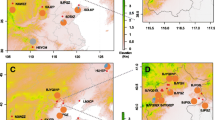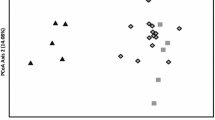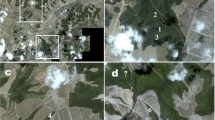Abstract
The extent of genetic differentiation between native and groundnut-feeding forms of the groundnut seed beetle Caryedon serratus Olivier was studied. Sixteen samples (560 individuals of both sexes collected in four localities in Senegal) of C. serratus were reared from pods of four distinct host plants (Arachis hypogaea L., Bauhinia rufescens Lam., Piliostigma reticulatum (DC) Hochst and Tamarindus indica L.), and five microsatellite loci were analysed. Phylogenetic and statistical analyses indicated that host plants strongly influence the degree of genetic differentiation between sampled individuals. Within host plants, genetic differentiation was low. Genetic differentiation between hosts was highly significant (average θ = 0.374) and geographical distances between localities did not influence the genetic structuration of C. serratus populations from a given host plant. The results of this study show that C. serratus could be under a host race formation process.
Similar content being viewed by others
References
Ali-Diallo B. (1991) Biologie de Caryedon serratus (Ol.) en présence de ses plantes hôtes sur le terrain et en conditions expérimentales. Thèse Université de Niamey, Tome 1. 103 pp.
Bernays E. A. and Chapman R. F. (1994) Host-plant Selection by Phytophagous Insects. Chapman & Hall, New York. 311 pp.
Bradshaw H. D., Wilbert S. M., Otto K. G. and Schemske D. W. (1995) Genetic mapping of floral traits associated with reproductive isolation in monkey flowers (Mimulus). Nature 376, 762–765.
Bush G. L. (1994) Sympatric speciation in animals: new wine in old bottles? Trends in Ecology and Evolution 9, 285–288.
Bush G. L., Feder J. L., Berlocher S. H., McPheron B. A., Smith D. C. and Chilcote C. A. (1989) Sympatric origins of R. pomonella. Nature 339, 346.
Bush G. L. and Smith J. S. (1998) The genetics and ecology of sympatric speciation. Research Population Ecology 40, 175–187.
Carroll S. P. and Boyd C. (1992) Host race radiation in the soapberry bug: natural history with the history. Evolution 46, 1052–1069.
Cavalli-Sforza L. L. and Edwards A. W. F. (1967) Phylogenetic analysis: models and estimation procedures. Evolution 21, 550–570.
Chakraborty R. and Jin L. (1993) A unified approach to study hypervariable polymorphisms: statistical considerations of determining relatedness and population distances, pp. 153–175. In DNA Fingerprinting: State of the Science (Edited by S. D. J. Pena, R. Chakraborty, J. T. Epplen and A. J. Jeffreys). Birkhauser Verlag Basel/Switzerland.
Cunnigham D. C. and Walsh K. B. (2002) Establishment of the peanut bruchid (Caryedon serratus) in Australia and two new host species, Cassia brewsteri and (1997) tomentella. Australian Journal of Experimental Agriculture 42, 57–63.
Davey P. M. (1958) The groundnut bruchid, Caryedon gonagra (F.). Bulletin of Entomological Research 49, 385–404.
Davies K. M. (1993) Isolation and characterization of a cDNA clone for a harvest-induced asparagine synthetase from Asparagus officinalis L. Plant Physiology 102, 1337–1340.
Delobel A. (1995) The shift of Caryedon serratus (Ol.) from wild Caesalpiniaceae to groundnuts took place in West Africa (Coleoptera: Bruchidae). Journal of Stored Products Research 31, 101–102.
Delobel A. and Delobel B. (2003) Les plantes hôtes des bruches de la faune de France, une analyse critique (Coleoptera Bruchidae). Bull. Soc. Linn. Lyon 72, 199–221.
Delobel A., Delobel H., Tran M., Sembène M. and Han S. H. (1995) Observations sur les relations trophiques entre les bruches du genre Caryedon (Coléoptères: Bruchidae) et leurs plantes hotes sauvages au Senegal. Bulletin Institut fondamental Afrique Blacke Cheikh Anta Diop, Dakar 48, 79–88.
Diehl S. R. and Bush G. L. (1984) An evolutionary and applied perspective of insect biotypes. Annual Review of Entomology 29, 471–504.
Estoup A. and Cornuet J. M. (1994) Utilisation de sondes oligonucléotidiques marquées à la digoxigénine pour la recherche de microsatellites. Journal of Biotechnology 10, 5–7.
Estoup A., Solignac M. and Cornuet J. M. (1994) Precise assessment of the number of patrilines and of genetic relatedness in honey bee colonies. Proceedings of the Royal Society of London, Biological Science 258, 1–7.
Farris J. S. (1970) Methods for computing Wagner trees. Systematic zoology 34, 21–34
Feder J. L. and Bush G. L. (1989) A field test of differential host plant usage between two sibling species of Rhagoletis pomonella fruit flies and its consequence for sympatric models of speciation. Evolution 43, 1813–1819.
Feder J. L., Opp S. B., Wlazlo B., Reynolds K., Go W. and Spisak S. (1994) Host fidelity is an effective premating barrier between sympatric races of the apple maggot fly. Proceedings of the National Academy of Sciences of the USA 91, 7990–7994.
Felsenstein J. (1985) Confidence limits on phylogenies: an approach using the bootstrap. Evolution 39, 783–791.
Felsenstein J. (1993) PHYLIP (Phylogenetic Inference Package), version 3.5c. Department of Genetics, University of Washington, Seattle, 145 pp.
Futuyma D. J., Keese M. C. and Scheffer S. J. (1993) Genetic constraints and the phylogeny of insect-plant associations: responses of Ophraella communa (Coleoptera: Chrysomelidae) to host plants of its congeners. Evolution 47, 888–905.
Futuyma D. J. and McCafferty S. S. (1990) Phylogeny and the evolution of the host plant associations in the leaf beetle genus Ophraella (Coleoptera: Chrysomelidae). Evolution 44, 1885–1913.
Gillier P. and Bockelée-Morvan A. (1979) La protection des stocks d’arachide contre les insectes. Oléagineux 3, 131–137.
Goodwin S. B. and Zismann V. L. (2001) Phylogenetic analyses of the ITS region of ribosomal DNA reveal that Septoria passerinii from barley is closely related to the wheat pathogen Mycosphaerella graminicola. Mycologia 93, 934–946.
Goudet J. (1995) Fstat (version 1.2): a computer program to calculate F-statistics. Journal of Heredity 86, 485–486.
Hedges L. V. (1992) Modelling publication selection effects in meta-analysis. Statistical Science 7, 246–255.
Hopkins A. D. (1917) A description of C.G. Hewitt’s paper on ‘Insect behavior’. Journal of Economic Entomology 10, 92–93.
Johnson C. D. (1966) Caryedon gonagra (Fab.) established in Mexico. Pan-Pacific Entomology 42, 162.
Kergoat G. J., Delobel A. and Silvain J.-F. (2004) Phylogeny and host-specificity of European seed beetles (Coleoptera, Bruchidae), new insights from molecular and ecological data. Molecular Phylogenetics and Evolution 32, 855–865.
Mitter C. and Futuyma D. J. (1979) Population genetic consequences of feeding habits in some forest Lepidoptera. Genetics 92, 1005–1021.
Miyatake T. and Shimizu T. (1999) Genetic correlations between life-history and behavioural traits can cause reproductive isolation. Evolution 53, 201–208.
Ndiaye S. (1991) La bruche de l’arachide dans un agrosystème du centre-ouest du Sénégal: contribution à l’étude de la contamination en plein champ et dans les stocks de l’arachide (Arachis hypogaea L.) par Caryedon serratus Ol. (Coleoptera-Bruchidae): rôle des légumineuses hôtes sauvages dans le cycle de cette bruche. Thèse Université de Pau et des Pays de l’Adour. 96 pp.
Nei M. (1978) Estimation of average heterozygosity and genetic distance from a small number of individuals. Genetics 89, 583–590.
Nilsson J. A. and Johnson C. D. (1992) New host, Bauhinia variegata L., and new locality records for Caryedon serratus (Olivier) in the New World. Pan-Pacific Entomologist 68, 62–63.
Pierre D. and Huignard J. (1990) The biological cycle of Caryedon serratus Ol. (Coleoptera, Bruchidae) on one of its host plants Bauhinia rufescens Lam. (Caesalpinioideae) in a Sahelian zone. Acta Oecologica 11, 93–101.
Raymond M. A. and Rousset F. (1995) Genepop (V. 1.2): a population genetics software for exact tests ecumenicism. Journal of Heredity 86, 248–249.
Rice W. R. and Hostert E. E. (1993) Laboratory experiments on speciation: what have we learned in 40 years. Evolution 47, 1637–1653.
Robert P. (1985) A comparative study of some aspects of the reproduction of three Caryedon serratus strains in presence of its potential host plants. Oecologia (Berlin) 65, 425–430.
Roubaud E. (1916) Les insectes et la dégénérescence des arachides au Sénégal. Mémoire Comité Etude historique et scientifique Afrique Occidentale Française 1, 363–438.
Saitou N. and Nei M. (1987) The neighbor-joining method: a new method for reconstructing phylogenetic trees. Molecular Biology and Evolution 4, 406–425.
Sembène M. (2004) Inter-strain fecundity and larval mortality in the groundnut beetle Caryedon serratus (Coleoptera: Bruchidae). International Journal of Tropical Insect Science 24, 319–322.
Sembene M. (2006) The origin of groundnut infestation by the seed beetle caryedon serratus (Coleoptera - Bruchidae): results from cytochrome and ITS1 gene sequences. Journal of Stored Products Research 42, 97–111.
Sembène M., Brizard J. P. and Delobel A. (1998) Allozyme variation among populations of groundnut seed-beetle Caryedon serratus (O1.) (Coleoptera: Bruchidae) in Senegal. Insect Science and Its Application 18, 77–86.
Sembène M. and Delobel A. (1996) Identification morphométrique de populations soudano-sahé-liennes de bruche de l’arachide, Caryedon serratus (Olivier) (Coleoptera Bruchidae). Journal of African Zoology 110, 357–366.
Sembène M. and Delobel A. (1998) Genetic differentiation of groundnut seed-beetle populations in Senegal. Entomologia Experimentalis et Applicata 87, 171–180.
Sembène M. and Delobel A. (2004) Mythe ou réalité? Le ‘principe de Hopkins’ dans le cas de la bruche de l’arachide Caryedon serratus (Coleoptera: Bruchidae). Bulletin de la Société entomologique de France 109, 61–66.
Sembene M., Vautrin D., Silvain J. F., Rasplus J. Y. and Delobel A. (2003) Isolation and characterization of polymorphic microsatellites in the groundnut seed beetle, Caryedon serratus (Coleoptera, Bruchidae). Molecular Ecology Notes 3, 299–301.
Shoemaker D. D. and Ross K. G. (1996) Effects of social organization on gene flow in the fire ant Solenopsis invicta. Nature 383, 613–616.
Silvain J. F. and Delobel A. (1998) Phylogeny of West African Caryedon (Coleoptera: Bruchidae): congruence between molecular and morphogical data. Molecular Phylogenetics and Evolution 9, 533–541.
Singer M. C. and Thomas M. D. (1988) Heritability of oviposition preference and its relationship to offspring performance within a single insect population. Evolution 42, 977–985.
Sokal R. R. and Rohlf F. J. (1981) Biometry. 2nd edn. W.H. Freeman and Co, New York/San Francisco. 859 pp.
Strauss S. Y. and Zangler A. R. (2002) Plant-insect interactions in terrestrial ecosystems, pp. 77–106. In Plant-Animal Interactions: An Evolutionary Approach (Edited by C. M. Herrera and O. Pellmyr). Blackwell Science, Massachusetts, USA.
Takezaki N. and Nei M. (1996) Genetic distances and reconstruction of phylogenetic trees from microsatellite DNA. Genetics 144, 189–399.
Via S. (2002) The ecological genetics of speciation. The American Naturalist 159, 81–87.
Vogler A. P. and DeSalle R. (1994) Evolution and phylogenetic information content of the ITS-1 region in the tiger beetle Cicindela dorsalis. Molecular Biology and Evolution 11, 393–405.
Weir B. S. and Cockerham C. C. (1984) Estimating F-statistics for the analysis of population structure. Evolution 38, 1358–1370.
Wright S. (1931) Evolution in Mendelian populations. Genetics 16, 97–159.
Wright S. (1978) Evolution and the Genetics of Populations. Vol. 4. Variability Within and Among Natural Populations. University of Chicago Press, Chicago.
Author information
Authors and Affiliations
Corresponding author
Rights and permissions
About this article
Cite this article
Sembèene, M., Rasplus, JY., Silvain, JF. et al. Genetic differentiation in sympatric populations of the groundnut seed beetle Caryedon serratus (Coleoptera: Chrysomelidae): new insights from molecular and ecological data. Int J Trop Insect Sci 28, 168–177 (2008). https://doi.org/10.1017/S1742758408094484
Accepted:
Published:
Issue Date:
DOI: https://doi.org/10.1017/S1742758408094484




